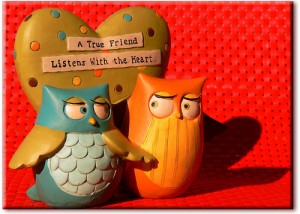When you listen, what resources do you call on most — your ears, mind, heart, intuition, or senses? Creative listening takes all of these tools and one invaluable motivator to tie it all together, a willingness to hear under the surface. The true value in any exchange, whether it takes place within yourself or with a partner or friend, is how you listen to what’s really being said. It’s the glue that acts as a bridge between the meaning, emotional connection and the truth for you.
The creative part of listening comes in when you know what action (or non-action) to take to support what you are really hearing. When you listen only with your mind you hear a very different message than if you pull in other senses to paint a fuller picture. The mind alone can be very bias, dragging in all sorts of junk to cloud the picture, and in turn, taking you down a path that is very narrow and myopic.
So to help shape a more balanced view through creative listening, the key is to start with observing how you listen.
The Key to Understanding How you Listen is also the Key to How you Receive
Each person has a unique blend of techniques they pull together for their own brand of creative listening. As an empath, I feel first, then acknowledge the words being shared, then decide what to take in to process and my final step is really “hearing” what the truth is for me in my heart.
Another example in creative listening is how the deaf process information. In my opinion they absolutely can hear, they just have a different way of listening that is guided by intuition and heart first. The same goes for blind people who are unable to see facial expressions.
How you access and pull together your creative listening “blend” is a bit of an exercise in trial and error combined with mindfulness of your own process. It’s taken me years to understand that auditory listening is not my strongest skill for listening (ironically), and that I really need time to process what is being said with the other sensations I’m feeling and intuiting. Then I can form a clearer picture to respond in a more rich, meaningful way instead of just what my mind “thinks” I should say.
To get a sense of your own creative listening process, it all starts with pace. Inner listening may be easier or more difficult, depending on how much time you take to slow down, and if you are willing to tune into yourself, pushing past mind chatter. How you listen to others can depend on if you are comfortable with a particular person or group, and how they choose to connect with and listen to you.
The key is not confusing your pace with someone else’s. It takes time and inner reflection to understand your nuances and why you choose to connect and listen the way you do. Honor that and don’t be afraid to tell others what works for you to help improve creative listening on both sides of the fence. Of course this isn’t always easy, but it’s also one of the reasons the book The 5 Love Languages is so popular. Even though our expression of love is comfortable and suits us, it doesn’t always match with how others are able to listen and receive it.
Trust your Own Creative Listening Process
There is no right way, no formula I can write for you to follow and apply. What I can say is that creative listening happens as a collaborative effort between your heart and mind. If you have a mental block about a person or situation rooted in fear, the only thing you may be able to hear is your mind telling you to run, instead of really looking at the value of how an experience can help you grow. That’s why the mind is so tricky — it can really twist around the truth of what you are hearing based on old ideas and fears.
The best guidance I can offer is that you spend some concentrated time being mindful of your interactions with others and yourself. If you notice that when “x” happens you are motivated to listen more, or conversely, shut down, then you can start identifying and getting in touch with the wonderful gifts available in your set of creative listening skills.
The key piece that most people miss is trust. When you notice patterns, trust them. Don’t go over analyzing or attempting to get the mind to explain them. Patterns are there to teach you more about yourself. Once you can see and accept them as part of you, it offers you the chance to open up to the creative freedom that comes from shifting them by using all of your creative listening tools as a guide, collectively.
Photo credit: higherinsights , Leonard John Matthews

